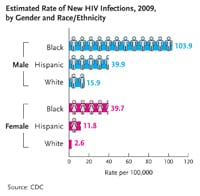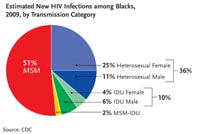National Black HIV/AIDS Awareness Day 2012
What You Can Do: Protecting Yourself from HIV
For NBHAAD, Dr. Kevin Fenton explains how you can protect yourself and your partners from HIV.
Get the Facts, Talk about HIV
On NBHAAD, Dr. Kevin Fenton encourages us to speak out about HIV.
HIV: What’s Driving the Epidemic in Black Communities?
Dr. Kevin Fenton discusses the complex factors fueling the HIV epidemic in black communities.
National Black HIV / AIDS Awareness Day (NBHAAD) Statement
NCHHSTP Director Dr. Kevin Fenton’s official statement in observance of NBHAAD.
Estimated Rate of New HIV Infections, 2009, by Gender and Race/Ethnicity
View High Resolution Versionimage icon
This graph shows that in the US in 2009 the rate of new HIV infections among black males was 103.9 cases per 100,000 population, the rate for Hispanic males was 39.9 cases per 100,000 population, and the rate for white males was 15.9 cases per 100,000 population. The rate among black females was 39.7 cases per 100,000 population, the rate for Hispanic females was 11.8 cases per 100,000 population, and the rate among white women was 2.6 cases per 100,000 population.
Estimated Number of New HIV Infections among Blacks, 2009, by Transmission Category
View High Resolution Versionimage icon
This pie chart shows the estimated new HIV infections among African Americans by transmission category for 2009. Men who have sex with men made up 51 percent of new HIV infections followed by heterosexuals who made up 36 percent of new HIV infections (25 percent for heterosexual females and 11 percent for heterosexual males), injection drug users who made up 10 percent of new HIV infections (4 percent for female IDU and 6 percent for male IDU), and MSM-IDU who made up 2 percent of new HIV infections.



